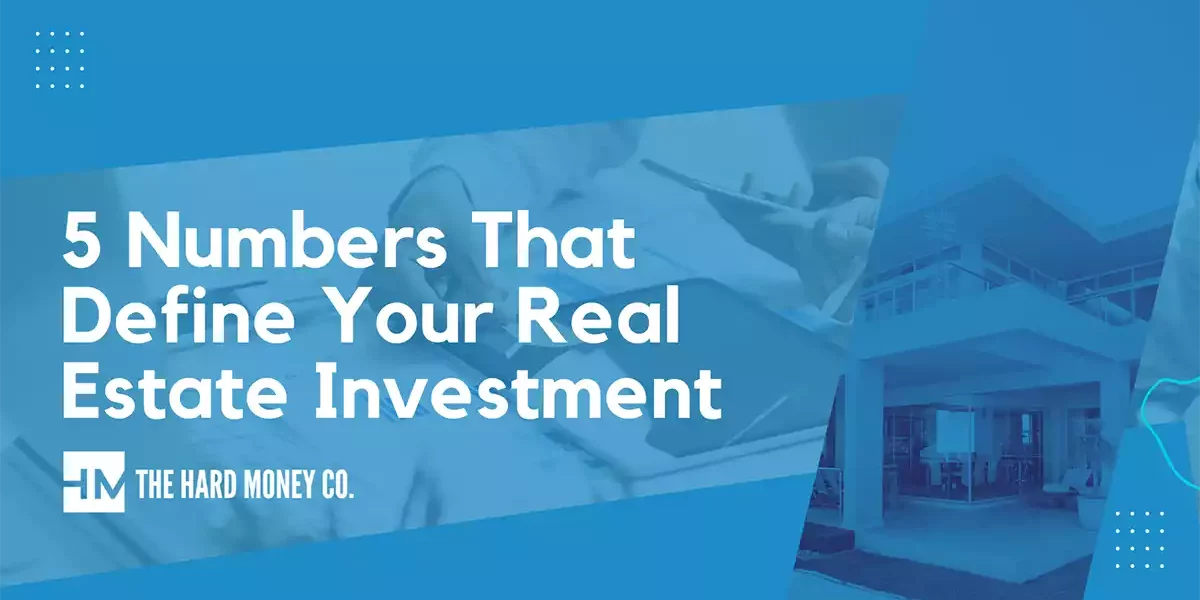There are a lot of variables in a fix and flip project. Creating a concrete plan for success means having an in-depth understanding of every financial variable in a project. But weighing the importance of these factors can be difficult. You need to know what to prioritize in order to create the most value and maximize your profit. At The Hard Money Co., we've partnered with thousands of investors and the most common theme of all the successes was discipline with the basics.
In our conversations, we've identified 5 numbers that will determine your success in a real estate investment project.
1. Purchase Price
2. Scope of Work
3. Closing Costs
4. Costs of Capital
5. Profit
While they may seem obvious, a strong understanding of each one of these numbers in your investment project will lead to success. It's also important to note that these figures aren't set in stone. It's up to you to influence each factor to the best of your ability to tip the scales of profitability in your favor. This article will give you some insights into why these 5 numbers are important, and how you can control them to maximize your return on investment.
1.) Purchase Price
Negotiation leads directly to increased profits
The purchase price is the defining variable in your investment project. Aside from it being the single biggest dollar value, it also sets the bar for every percentage-based figure that follows. The list price is simply what the seller is asking for and while that occasionally may be the fair market value of the property, more often than not it is inflated far beyond what the seller would actually accept. Failure to aggressively negotiate this price shortchanges your profit and can put you behind before you even begin.
For most people when they look at the price tag of a home, the difference between $290,000 and $300,000 barely registers. Financed over 30 years this difference would only cost the owner roughly $50 a month and might be the difference between finding a home. Investors can't have this mindset. That $10,000 is coming directly out of your pocket. Every penny that you save on the purchase price bears out in your overall profitability. Additionally, most downstream fees are based on the purchase price (financing costs, origination fees, broker fees, etc.). The savings you make by negotiating can have significant compounding savings over the life of a loan.
Research will lead the way
But before you can employ your negotiation skills to make a great deal, you have to do the legwork to determine if the property has the potential to be a good deal. How do you determine whether the price of a given property is fair? We know that we can't use competing offers as a barometer. The housing market is so hot right now that people are offering 20-30% over prices from just a year ago. If you matched those prices today, what are the odds that the market is in a similar position a year from now? Buying at prices set by the market is a risky proposition. You may be able to time the transaction it's possible that the market falls back to earth and you're stuck with an inflated budget in a deflated market. Is your business in a position to withstand this level of market volatility?
The most important aspect of identifying a fair price for your potential investment property is by exploring comparable properties in the area. This will give you an idea of fair value is in actuality. Look at core features such as square footage, number of beds and baths, and relative age of the home to find a baseline for your expected price. From there, you can dig deeper and see what amenities included in (or absent from) the home may raise (or lower) your price. This should give you a strong sense of what your renovated home may yield on the open market.
But knowing what a fully renovated home is worth doesn't help you, the flipper when trying to set your purchase price. You need to acquire the property at a price significantly less than that to account for fees, renovations, and your profit. We recommend aiming for a purchase price of around 70% of your After Repair Value, or the comp price that you just found.
At this point, you've established your ARV and arrived at a purchase price that you feel comfortable with. Trust your work. If the seller is not willing to accommodate your price point, be willing to move on. The property is only as its financials, and if you can't extract an acceptable margin by establishing a low purchase price, you will not generate the ROI that you're looking for.
2.) Scope of Work
In a fix and flip, the value that you bring to the transaction is in the renovation. This is where you deliver the property from its state of disrepair and make it an attractive home for future buyers or renters. But repairs can be expensive. Even if the After Repair Value (ARV) is substantially improved, you still need to manage your costs to extract as much profit as you can. This is where a diligently prepared Scope of Work can make a difference. A Scope of Work is a document that outlines which repairs you intend to make and how much they will cost. Taken a step further, you could also include details such as who will do the work, when it will be complete, and how much the repair will contribute to the bottom line.
At The Hard Money Co., we require a detailed Scope of Work for every transaction. THMC provides repair funds for all of our borrowers that allows them to complete necessary renovations. A detailed accounting of work to be done allows us to help maximize your profitability. It also helps you put together a clear strategy and timeline at the start of your project. This keeps you accountable and can act as a warning if you start to get off track.
As you're beginning your real estate investing journey, the Scope of Work will prove to be an invaluable tool for you. Experienced investors are at an advantage as they've already developed relationships with contractors and have an intuitive understanding of what repairs cost and how long they take. More importantly, they know which repairs contribute most to the bottom line. Replacing an outdated furnace or AC unit almost certainly generates a positive ROI. The same can't be said for amenities like a pool or high-end appliances. At best, these might be break-even expenses. Your goal should be to maximize ROI on every dollar spent and developing a solid plan from the outset will allow you to do so.
A Scope of Work will also give you the opportunity to value your own time and energy properly. Consider budgeting in your management hours or the labor of repairs that you intend to do yourself. Does the project still look as profitable if you account for your own efforts? Luckily, these are questions that you don't have to answer yourself. If you provide a detailed Scope of Work in your hard money application. Our team will work with you to review your strategy and ensure that you are set up for success.
3.) Transaction Costs
Executing a real estate deal involves a lot of people who each bring a distinct value to the transaction. Each of these people expects to be paid accordingly and their compensation comes directly out of your potential property. This can be a good thing! Having talented partners to help you along the way can expedite the purchase/sale of your property and can eliminate many of the headaches associated with real estate deals. One of the biggest mistakes that inexperienced investors make is overlooking these costs. The second biggest mistake is trying to cut corners to avoid these necessary steps altogether. Origination fees, title costs, brokerage commissions, and legal fees are all legitimate expenses that occur during a project. Including them in your strategy by using something like the 70% rule can be an effective way to ensure your project remains profitable.
4.) Cost of Capital (Carrying Costs)
Very few real estate investors use their own capital to finance their fix and flip projects. In the vast majority of cases, investors will use outside capital to acquire the properties and finance the renovations. This can come from any number of sources including friends, family, traditional institutions, or hard money lenders. Each has its own set of risks and rewards, but the one thing they all have in common is the cost of capital. When someone lends you money, they expect to be compensated through interest. This cost needs to be factored into your initial investment strategy and weighed against your project timeline. The longer your project takes, the more opportunity these costs have to accrue which can significantly eat into your overall profitability.
Experienced investors will have a range of funding sources at their disposal. This allows them to select the option that best suits the project in from of them. Friends and family may be able to contribute funds, but they also might require some equity in the investment. It also can put stress on personal relationships that may not be best for everyone involved. Traditional lenders can often provide cheap financing, but they move slowly and won't touch many types of investments. They have their place, but only in specific circumstances. Hard Money lenders, like The Hard Money Co., are especially suited for short-term, fix and flip projects. They are able to move fast, will lend to unique opportunities, and have the experience to help you along the way. The downside is that they can be more expensive than other options. It's up to you to consider which source is best for your particular opportunity. If you question whether Hard Money is the right source for you, give us a call. A no-pressure consultation with one of our originators will give you the insight you need to be successful.
5.) Profit
I know what you're thinking. Why did it take us so long to get to the most important metric in our whole investment strategy? The answer is simple; profit is what's leftover. If you fail to successfully navigate the four numbers that come before you're not going to have any profit. Profit is the summation of all your hard work and reflects how well you managed your investment. Maximizing it means that you've executed a sound strategy for each of these components:
1. Purchase: You got the property at the best price possible
2. Repairs: You maximized your ARV in the most efficient way possible.
3. Fees: You budgeted for your costs of doing business and ensured that your transaction went smoothly
4. Cost of Capital: The price you paid for financing best suits your investment strategy
5. Profit: Your rewards for a job well done
In Closing…
We do this every day for hundreds of investors all over the country. Borrowers of all experience levels have worked with us to secure investment properties that net them tens of thousands of dollars of profit. If you have any questions or comments about the information here, or any other topic in real estate investing, don't hesitate to reach out. We want you to view us as your partner because that’s how we see you.


